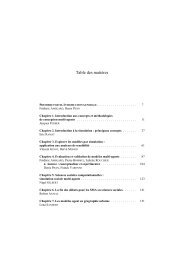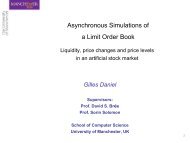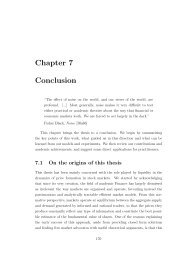market architecture of selected stock exchanges in ... - Gilles Daniel
market architecture of selected stock exchanges in ... - Gilles Daniel
market architecture of selected stock exchanges in ... - Gilles Daniel
You also want an ePaper? Increase the reach of your titles
YUMPU automatically turns print PDFs into web optimized ePapers that Google loves.
37limit <strong>of</strong> a buy (sell) order is usually lower (higher) than the best counterpart <strong>of</strong>fer(bid) prevail<strong>in</strong>g at the time the order is placed <strong>in</strong> a cont<strong>in</strong>uous <strong>market</strong>. On occasion,they may not execute at all. If a limit order does execute, it generally does so at itslimit price. S<strong>in</strong>ce “they establish the prices at which <strong>market</strong> order placers can trade,limit orders traders are characterized as immediacy-suppliers”(Be<strong>in</strong>er and Schwartz2001, p.102).In a call auction, limit orders execute at the common clear<strong>in</strong>g prices, not at the pricesat which they are written. Hence, orders that can be executed are all <strong>market</strong> buyorders, buy limit orders at the clear<strong>in</strong>g price and above, all <strong>market</strong> sell orders and selllimit orders at the clear<strong>in</strong>g price and below. In a call auction, there is no differencebetween limit and <strong>market</strong> orders. Market orders are executed at the prevail<strong>in</strong>g price<strong>in</strong> the <strong>market</strong> and thus can be seen as “a limit order placed at an arbitrarily high price(for a buy order) or an arbitrarily low price (for a sell order)” (Be<strong>in</strong>er and Schwartz2001, p.103). Therefore, <strong>market</strong> orders will generally execute <strong>in</strong> a call <strong>market</strong>although this may not be stated by the rules <strong>of</strong> the respective <strong>exchanges</strong> (Be<strong>in</strong>er andSchwartz 2001).Table 15: Order Handl<strong>in</strong>g <strong>in</strong> Call vs. Cont<strong>in</strong>uous MarketsCont<strong>in</strong>uous OrderDriven MarketCall AuctionMarket OrdersExecute at the best counterpart quoteExecute immediatelyImmediacy demand<strong>in</strong>gExecute at the clear<strong>in</strong>g priceNo immediate executionNot immediacy demand<strong>in</strong>gSource: Be<strong>in</strong>er and Schwartz (2001)Limit OrdersExecute at price <strong>of</strong> the orderDelayed or no executionImmediacy supply<strong>in</strong>gExecute at the clear<strong>in</strong>g priceNo immediate executionNot immediacy demand<strong>in</strong>g3.6.2 Order Rout<strong>in</strong>gAfter the <strong>in</strong>vestor has def<strong>in</strong>ed the order type, its execution condition and validity, theorder is sent to the broker, whether written via an automated system or verbal e.g. viatelephone. However, it is up to the broker to seek the best execution available. Thereare different channels the broker can use for trade execution (see Figure 9) - whichone he uses determ<strong>in</strong><strong>in</strong>g the order flow is called order rout<strong>in</strong>g.







